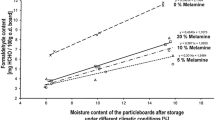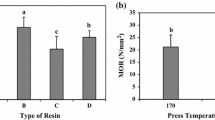Abstract
Potential use of condensate generated by cooling the steam obtained during high-frequency/vacuum drying step of hardwood lumber was investigated. The liquid condensates were obtained from oak, beech and walnut wood. This liquid condensate was then used as a replacement for deionized water in the synthesis of Urea-Formaldehyde (UF) resin (5 wt% of total resin) using a laboratory scale reactor. Medium Density Fibreboards (MDFs) were produced using control and modified resins. Emissions of Volatile Organic Compounds (VOCs) from the MDFs were determined by Mcro Chamber method. The bonding properties of the MDFs were determined according to European standards. The main VOC emissions from MDFs produced using UF resin containing the condensate were a-Pinene, b-Pinene, careen, and acetic acid, which were lower than those of the control MDF, except for the acetic acid emission of MDF with oak condensate. In the tree species, the beech wood condensate gave the lowest VOC emissions (732 μgm-3) from the MDFs, followed by the MDFs containing walnut wood condensate (852 μg·m3), oak wood condensate (998 ugnf3), and control MDF (3529 μg-3), respectively. However, the internal bond strength of MDFs containing the condensate was negatively impacted by the condensate (0.70 N·mnf-2 to 0.54 N·mm-2 depending on the tree species). The results showed that the liquid wood-drying condensate which generally released to the ground could be efficiently used as an alternative to expensive VOCs scavenger used in the production of UF resin bonded MDF. This may be one of the most efficient uses of the condensate in high value-added materials.
Similar content being viewed by others
References
Bucko J, Baloghova D, Kacyk F. Chemical characteristic of hardwoods subjected to vacuum drying. Proceedings of International Conference on Wood Drying: Vacuum Drying of Wood, Bratislava, Slovakia, 1993, 199–205.
Ayrilmis N, Gilrel A, Kapti T, Ohlmeyer M. Reducing formaldehyde emission from wood-based panels by modification of UF and MUF resins with condensates obtained from kiln-drying of wood. Reducing formaldehyde emission from wood-based panels by modification of UF and MUF resins with condensates obtained from kiln-drying of wood, 2018, 72, 753–757.
Prokkola H, Kuokkanen M, Kuokkanen T, Lassi U. Chemical study of wood chips drying: Biodegradation of organic pollutants in condensate waters from the drying process. Chemical study of wood chips drying: Biodegradation of organic pollutants in condensate waters from the drying process, 2014, 9, 3761–3778.
Roffael E, Dix B, Greubel D. Method for Producing a Binder Solution, patent number: EP1284845 Al, Munich, Germany, 2001.
Ayrilmis N, Gilrel A, Ozdemir M, Kapti T. Bond performance of formaldehyde-based resins synthesized with condensate generated during kiln-drying step of wood. Bond performance of formaldehyde-based resins synthesized with condensate generated during kiln-drying step of wood, 2018, 63, 97–104.
EN 12765. Classification of Thermosetting Wood Adhesives for Non-structural Applications, European Committee for Standardization, Brussels, Belgium, 2002.
Yazdi H K, Fathalizadeh Y Relationship between sick building syndrome with headache and drowsiness. International Journal of Advanced Biological and Biomedical Re-search, 2014, 2, 510–516.
Vaisanen T, Heikkinen J, Tomppo L, Lappalainen R. Softwood distillate as a bio-based additive in wood-plastic composites. Softwood distillate as a bio-based additive in wood-plastic composites, 2010, 36, 278–287.
He Z K, Zhang Y P, Wei W J. Formaldehyde and VOC emissions at different manufacturing stages of wood-based panels. Formaldehyde and VOC emissions at different manufacturing stages of wood-based panels, 2012, 47, 197–204.
Stefanowski B, Curling S F, Ormondroyd, G A. The sorption of Volatile Organic Compounds (VOCS) by modified MDF panels and effects on mould colonisation and growth. The International Panel Products Symposium, Llandudno, UK, 2015.
Rong H, Ryu Z, Zheng J, Zhang Y. Effect of air oxidation of rayon-based activated carbon fibres on the absorption behaviour for formaldehyde. Effect of air oxidation of rayon-based activated carbon fibres on the absorption behaviour for formaldehyde, 2002, 40, 2291–2300.
Dedic D. The Warship Vasa: A Study ofLignin, Extractives and Acids in the Oak Wood, PhD thesis, KTH Royal Institute of Technology, Stockholm, Sweden, 2013.
Dejmal A, Zejda J. The analysis of condensate fluid from wood drying in the condensation drying kiln. The analysis of condensate fluid from wood drying in the condensation drying kiln, 2008, 5, 31–38.
McDonald A G, Gifford J S, Dare P H, Steward D. Characterisation of the condensate generated from vacuum-drying of radiata pine wood. Characterisation of the condensate generated from vacuum-drying of radiata pine wood, 1999, 57, 251–258.
EN 317. Particleboards and Fiberboards-Determination of swelling in Thickness after Immersion in Water, European Committee for Standardization, Brussels, Belgium, 1993.
EN 310. Determination of Bending Strength andModulus of Elasticity, European Committee for Standardization. Brussels, Belgium, 1993.
EN 319. Particleboards and Fiberboards; Determination of Tensile Strength Perpendicular to the Plane of the Board, European Committee for Standardization, Brussels, Belgium, 1993.
EN 323. Determination of Density, European Committee for Standardization, Brussels, Belgium, 1993.
Gadhave R V, Mahanwar P A, Gadekar P T. Factor affecting gel time/process-ability of urea formaldehyde resin based wood adhesives. Factor affecting gel time/process-ability of urea formaldehyde resin based wood adhesives, 2017, 7, 33–42.
Ayrilmis N, Kaymakci A. Reduction of formaldehyde emission from light MDF panels by adding chestnut shell flour. Reduction of formaldehyde emission from light MDF panels by adding chestnut shell flour, 2011, 66, 443–446.
Ayrilmis N, Buyuksari U, Avci E, Koc E. Utilization of pine (Pinus pinea L.) cone in manufacture of wood based composite. Utilization of pine (Pinus pinea L.) cone in manufacture of wood based composite, 2009, 259, 65–70.
Nemli G, Colakoglu G. Effects of mimosa bark usage on some properties of particleboard. Effects of mimosa bark usage on some properties of particleboard, 2005, 29, 227–230.
Chen T Y, Paulitsch M. The extractives of needles, bark, and wood of pine and spruce and their effect on particleboards made thereof. The extractives of needles, bark, and wood of pine and spruce and their effect on particleboards made thereof, 1972, 32, 397–401.
Xing C, Zhang S Y, Deng J. Effect of wood acidity and catalyst on UF resin gel time. Effect of wood acidity and catalyst on UF resin gel time, 2004, 58, 408–412.
Park B D, Kim Y S, Riedl B. Effect of wood-fiber characteristics on medium density fiberboard (MDF) performance. Effect of wood-fiber characteristics on medium density fiberboard (MDF) performance, 2001, 29, 27–35.
Johns W E, Niazi K A. Effect of pH and buffering capacity of wood on the gelation time of urea-formaldehyde resin. Effect of pH and buffering capacity of wood on the gelation time of urea-formaldehyde resin, 1980, 12, 255–263.
Wang X, Huang Z, Cooper P, Wang X M, Zhang Y, Casilla R. The ability of wood to buffer highly acidic and alkaline adhesives. The ability of wood to buffer highly acidic and alkaline adhesives, 2010, 42, 398–405.
Gao Z H, Wang X M, Wan H, Liu Y. Curing characteristics of urea-formaldehyde resin in the presence of various amounts of wood extracts and catalysts. Curing characteristics of urea-formaldehyde resin in the presence of various amounts of wood extracts and catalysts, 2008, 107, 1555–1562.
Xu J, Zhang X L. Fulvic Acid-isocyanate Modified Urea Resin Adhesive and Preparation Method Thereof, patent number: CN103409089A, Hefei, China, 2013.
Baumann M G D, Stuart L F, Batterman S A, Zhang G Z. Aldehyde emissions from particleboard and medium density fiberboard products. Aldehyde emissions from particleboard and medium density fiberboard products, 2000, 50, 75–82.
Rathke J, Stratev D. Analysis of the chemical constituents of dry-kiln condensate and its technological recovery - Part 1: volatile extractives. Analysis of the chemical constituents of dry-kiln condensate and its technological recovery - Part 1: volatile extractives, 2013, 8, 5783–5793.
Vivas N, Laguerre M, Glories Y, Bourgeois G, Vitry C. Structure simulation of two ellagitannins from Quercus robur L. Phytochemistry, 1995, 39, 1193–1199.
Jensen L K, Larsen A, Møhave L, Hansen M K, Knudsen B. Health evaluation of volatile organic compound (VOC) emissions from wood and wood-based materials. Archives of Environmental Health: An International Journal, 2001, 56, 419–432.
USGBC (U.S. Green Building Council). LEED v4 User Guide, Washington DC: USGBC, 2014. [2018-01-20], http://www.usgbc.org/resources/leed-v4-user-guide
Acknowledgments
This work was financially supported by the Research Fund of Istanbul University-Cerrahpasa (No: BEK-2017-26341).
Author information
Authors and Affiliations
Corresponding author
Rights and permissions
About this article
Cite this article
Ayrilmis, N., Kapti, T., Gürel, A. et al. Effect of Wood-drying Condensate on Emission of Volatile Organic Compounds and Bonding Properties of Fibreboard. J Bionic Eng 17, 206–214 (2020). https://doi.org/10.1007/s42235-020-0016-5
Published:
Issue Date:
DOI: https://doi.org/10.1007/s42235-020-0016-5




